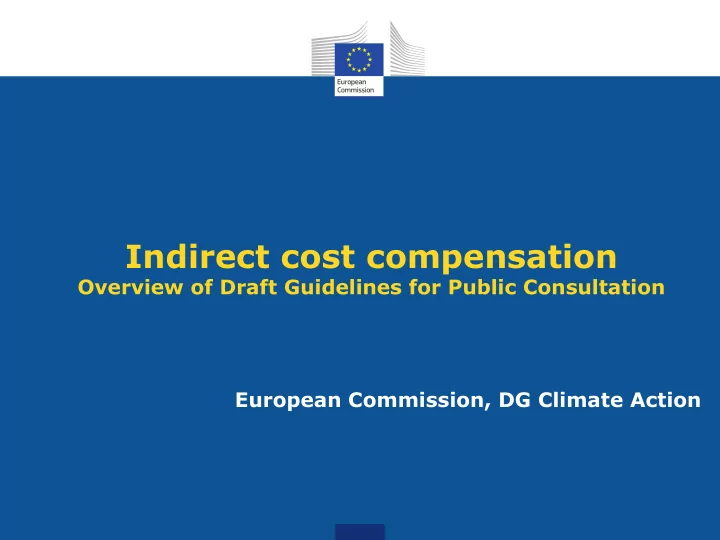

Indirect cost compensation Overview of Draft Guidelines for Public Consultation European Commission, DG Climate Action
Background Legal basis: Article 10a(6) ETS Directive State aid rules apply State aid competence exercised by DG Competition Current ETS Guidelines run until 31 December 2020 Revision process started in 2018 Draft Guidelines for eight-week public consultation until 10 March 2020 Adoption envisaged well ahead of the start of Phase IV 2
Content – Key topics Eligibility: which sectors may receive compensation? Aid intensity: which percentage of eligible costs can be compensated? Degressivity and efficiency benchmarks Emission factor: how much CO2-costs are in purchased electricity? Conditionality 3
Eligibility Free allocation methodology used as a basis, but with indirect emission data only Quantitative criteria informed by a qualitative assessment Indirect carbon leakage indicator required for eligibility is 0.2, whereby: Trade intensity* must be at least 20% and Indirect emission intensity* must be at least 1 kgCO2/EUR Trade intensity = (Imports + Exports) / (Turnover + Imports) Indirect emission intensity = Indirect emissions / GVA 4
Eligibility Eight sectors are on the list: 1. Manufacture of leather clothes, 2. Aluminium production, 3. Manufacture of other inorganic basic chemicals, 4. Lead, zinc and tin production, 5. Manufacture of pulp, 6. Manufacture of paper and paperboard, 7. Manufacture of basic iron and steel and ferro-alloys and 8. Manufacture of refined petroleum products Explanatory Memorandum opens the door for qualitative assessment: The Commission may decide to include additional sectors, in light of the feedback and evidence received in the public consultation, based purely on qualitative considerations provided the sectors concerned have at least an indirect carbon leakage indicator of 0.2 and that their carbon leakage risk as evaluated by the consultant in the study 5 is at least medium.
How much aid per eligible installation? Guidelines determine the maximum with a formula: Amaxt = Ai × Ct × Pt-1 × E × Aot In this formula, Ai is the aid intensity, expressed as a fraction; Ct is the applicable CO2 emission factor (tCO2/MWh) (at year t); Pt-1 is the EUA forward price at year t-1 (EUR/tCO2); E is the applicable product-specific electricity consumption efficiency benchmark defined in Annex II; and AOt is the actual output in year t. Fallback benchmark for products without product-specific benchmark 6
Aid intensity Stable level of 75% throughout Phase IV NEW: Possibility for extra support for installations with particularly high exposure (‘GVA - cap’) – similar to EEAG 7
Degressivity and efficiency benchmarks Degressivity to be replaced by twice updated efficiency benchmarks Methodology consistent with free allocation method Benchmarks yet to be determined Product-specific or fallback benchmarks; exchangeability to be taken into account 8
Emission Factor Regional approach maintained Absence of price convergence on the electricity market results in fewer regions and more national factors Calculation methodology to remain unchanged until 2025: marginal plant approach based on fossil fuels Actual factors to be calculated and inserted in final version 9
NEW - Conditionality Chapter 5 of Draft Guidelines – Energy Audits and EMS Aid to be invested in efficiency measures Alternatively: RES PPA or innovation investments 10
Next steps Public consultation until 10 March 2020 11
Thank you! Visit DG Climate Action online: facebook.com/ twitter.com/ pinterest.com/ youtube.com/ ec.europa.eu/ EUClimateAction EUClimateAction EUClimateAction EUClimateAction clima/
Recommend
More recommend